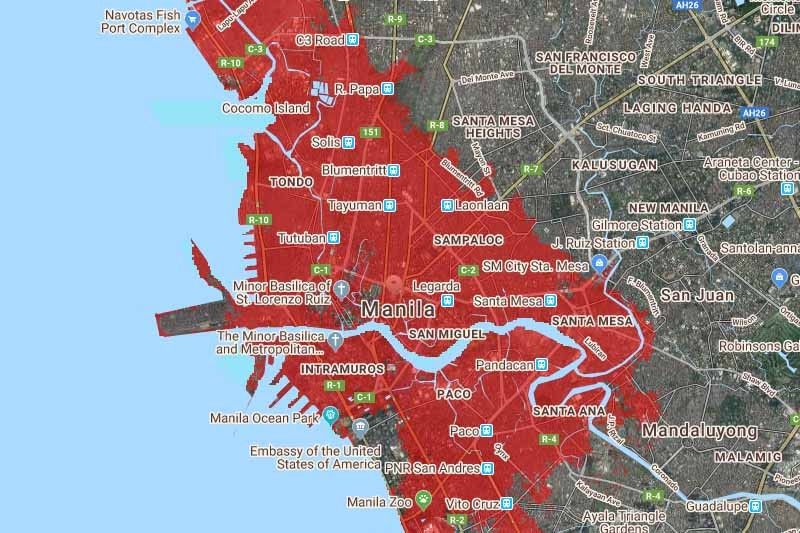In 30 years, rising seas will threaten Philippine cities, towns home to 6.8 million

MANILA, Philippines — In only three decades, areas in the Philippines now home to around 6.8 million people will likely be inundated as the sea levels continue to rise.
By the end of the century, land currently occupied by 8.6 million Filipinos could be lower than the height of average annual coastal flood.
The figures are among the findings of the study produced by New Jersey-based science organization Climate Central.
The research, published in the journal Nature Communications, found that 250 million people across the globe currently live on land below current annual flood levels and 110 million live below the high tide line at present.
Using a more accurate way of calculating land elevation called CoastalDEM, the study of authors Scott Kulp and Benjamin Strauss suggests there are 5.4 million Filipinos already occupying land below annual flood levels.
Annual flood level is used to denote the water level at the shoreline that local coastal floods exceed on average once per year.
Conservative estimates
The new projections for the Philippines—an archipelago in the Pacific Ocean—are based on a relatively conservative scenario of expected changes. This assumes humans will moderately reduce warming emissions roughly in line with the 2015 Paris climate agreement’s two-degree Celsius target and there will be a fairly stable Antarctica.
The numbers also used by the authors were based on a 2010 population data—100 million.
But assuming the high greenhouse gas-emissions continue unabated along with Antarctic instability, seven million Filipinos live on land that could be threatened by inundation by mid-century. By 2100, the number will rise to 13 million.
Olongapo City
7 million Filipino below high tide line by 2050
The new data showed that 4.3 million people in the Philippines live in places that are below the high tide line.
Tideline is used to indicate the long-term average of the highest daily local tide level.
“[This] suggests that this land is protected today, possibly by coastal defenses. It is also possible that our data underestimate elevation in some places,” Peter Girard, director of communications at Climate Central, told Philstar.com.
Even under a highly optimistic scenario, 5.2 million Filipinos will occupy land that will be underwater at high tide by 2050. The number will increase to 6.9 million by the end of the century.
If emissions continue to rise, land currently home to 5.4 million Filipinos will fall below the level of high tide by mid-century. By 2100, the number will double to 11 million.
Roxas City
Vulnerable areas
The study suggests that waters threaten to consume Metro Manila—the country’s political and economic center—and areas in Bulacan facing Manila Bay.
City of Manila
Southwestern Metro Manila
An airport city complex is set to rise over the northern coast of Manila Bay, with environmental groups fearing that the reclamation will bring intense flooding in the coastal and low-lying areas of Bulacan and in nearby places.
Northwestern Metro Manila and parts of Bulacan
Special report: Fed by the waters
Cebu City—the center of commerce, trade and education in Visayas—and Zamboanga City are also imperiled, according to the study.
Cebu City
Zamboanga City
The greatest effects of the sea level rise will be felt in Asia.
Mainland China, Bangladesh, India, Vietnam, Indonesia and Thailand account for roughly 75% of the 300 million people on land projected to be below average annual coastal flood levels at mid-century, the report said.
The research shows that urgent shifts in action are needed to prevent catastrophic changes across the globe, Girard said.
“Governments can take two critical actions to avoid the most severe consequence: cut carbon emissions as much and as quickly as possible to slow the pace of sea level rise,” he said.
“That will provide more time to determine how to respond to this threat and to plan and build coastal defenses to protect their citizens.”
Rising seas
The report of the United Nations-backed Intergovernmental Panel on Climate Change released in September showed that the world’s oceans and cryosphere—glaciers and polar regions—are getting warmer, more acidic and less productive.
Iloilo City
Sea levels are projected to rise nearly half a meter by 2100 if Earth warms 2 degrees celsius above pre-industrial levels and 84 centimeter in a 3C to 4C world.
Climate Change Commissioner Rachel Herrera earlier told Philstar.com that rising sea levels will likely cause more storm surges and flooding and endanger coastal communities.
“The most affected sectors will be agriculture and fisheries, impacting on fish catch and our food supply,” she said.
Global temperatures have increased 1 degree celsius above pre-industrial levels and are on track to rise another two or three degrees by 2100.
If the Paris treaty’s goal of capping warming at 1.5 to 2 degrees celsius is to be met, emissions of warming gases must drop to 50% by 2030 and to “net zero” by 2050 IPCC concluded in a report released in 2018. — with a report from Agence France-Presse; Interactive threat maps courtesy of Climate Central's Coastal Risk Screening Tool
Editor's Note: If you can't see the maps above, you might be viewing this story on Google Amp. View them on Philstar.com
- Latest
- Trending
































